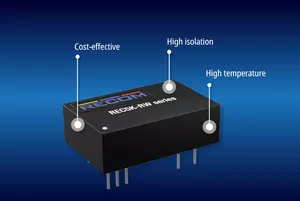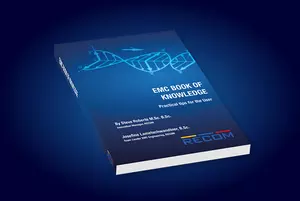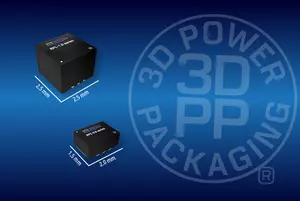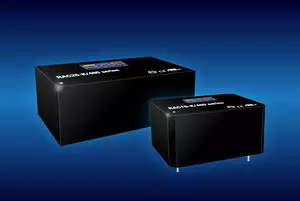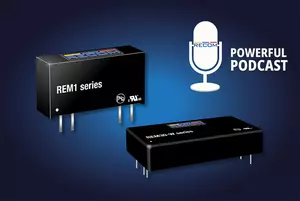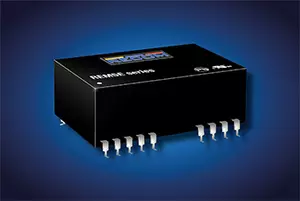|
1
|
|
REC10K-AW
Focus
(20 products)
|
- Industry standard 10W 1”x1” package
- Derates to 100°C ambient temperature
|
- Wide 4:1 input
- ON/OFF control pin, UVLO, SCP
|
|
|
|
|
2
|
|
REC10K-RW
Focus
New
(20 products)
|
- Industry standard 10W DIP24 package
- Derates to 100°C ambient temperature
|
- Wide 4:1 input
- ON/OFF control pin, UVLO, SCP
|
|
|
|
|
3
|
|
REC150H-UW
Focus
(5 products)
|
- 150W DC/DC converter in Half Brick format
- 9-75VDC ultra wide input voltage range
|
- 2.5kVDC/1 minute insulation
- Efficiency up to 89.5%
|
|
|
|
|
4
|
|
REC20K-Z
Focus
(16 products)
|
- Industry standard 20W 1”x1” package
- Derates to 105°C ambient temperature
|
- Wide 4:1 input
- ON/OFF control pin, UVLO, SCP
|
|
|
|
|
5
|
|
REC300H-W
Focus
(4 products)
|
- 300W DC/DC converter in Half Brick format
- 9-36VDC wide input voltage range
|
- 3kVDC/1 minute insulation
- Fully protected with UVLO, SCP, OVP, and OLP
|
|
|
|
|
6
|
|
REC30E-Z
Focus
(14 products)
|
- 30W in a 1”x1” case
- 4:1 wide input voltage range
|
- 2kVDC/1min isolation
- IEC/EN62638-1certified
|
|
|
|
|
7
|
|
REC30K
Focus
(27 products)
|
- Industry standard 30W 1”x1” package
- Derates to 105°C ambient temperature
|
- Wide 2:1 and 4:1 input ranges
- ON/OFF control pin, UVLO, SCP
|
|
|
|
|
8
|
|
REC3A-W
Focus
(4 products)
|
- 2:1 input voltage range
- Efficiency up to 81%
|
- EMI Class A without external components
- Continuous short circuit protection
|
|
|
|
|
9
|
|
REC5A-W
Focus
(4 products)
|
- 2:1 input voltage range
- Efficiency up to 81%
|
- EMI Class A without external components
- Continuous short circuit protection
|
|
|
|
|
10
|
|
REC5K-AW
Focus
(1 product)
|
- 4kVDC/1sec isolation
- Industry standard 5W 1”x1” package
|
- Feedback regulated output
- Derates to 110°C ambient temperature
|
|
|
|
|
11
|
|
REC5K-RW
Focus
(2 products)
|
- 4kVDC/1sec isolation
- Industry standard 5W DIP24 package
|
- Low ripple and noise
- Derates to 110°C ambient temperature
|
|
|
|
|
12
|
|
REC6A-W
Focus
(4 products)
|
- 2:1 input voltage range
- Efficiency up to 80%
|
- EMI Class A without external components
- Continuous short circuit protection
|
|
|
|
|
13
|
|
REC8E
Focus
(21 products)
|
- 8W in a compact 1x1” package
- 2:1 input voltage range
|
- 12, 24, and 48VDC nominal voltage options
- UL/IEC/EN62368-1 + IEC60950-1 (pending)
|
|
|
|
|
14
|
|
REC10-RW
(108 products)
|
- 10W DIP24 Package
- 2KVDC and 3kVDC Isolation Options
|
- 2:1 and 4:1 Versions
- Continuous Short Circuit Protection (power limiting)
|
|
|
|
|
15
|
|
REC10-RWZ
(72 products)
|
- 10W DIP24 Package
- 2KVDC and 3kVDC Isolation Options
|
- 2:1 and 4:1 Versions
- Continuous Short Circuit Protection (power limiting)
|
|
|
|
|
16
|
|
REC10-Z/M
(28 products)
|
- 10W in 2” x 1” Package
- 2kVDC and 3kVDC Isolation Options
|
- 2:1 or 4:1 Input Voltage Range
- Continuous Short Circuit Protection (power limiting)
|
|
|
|
|
17
|
|
REC10/M
(42 products)
|
- 10W in 2” x 1” Package
- 2kVDC and 3kVDC Isolation Options
|
- 2:1 or 4:1 Input Voltage Range
- Continuous Short Circuit Protection (power limiting)
|
|
|
|
|
18
|
|
REC15-Z/M
(56 products)
|
- 15W in 2” x 1” Package
- 2kVDC and 3kVDC Isolation Options
|
- 2:1 or 4:1 Input Voltage Range
- Continuous Short Circuit Protection (Power Limiting)
|
|
|
|
|
19
|
|
REC15/M
(84 products)
|
- 15W in 2” x 1” Package
- 2kVDC and 3kVDC Isolation Options
|
- 2:1 or 4:1 Input Voltage Range
- Continuous Short Circuit Protection (Power Limiting)
|
|
|
|
|
20
|
|
REC15E-Z
(28 products)
|
- 4:1 wide input voltage range
- Compact size 1"x1" package
|
- Efficiency up to 90%
- Wide operating temperature from -40°C to +75°C without derating
|
|
|
|
|
21
|
|
REC20
(18 products)
|
- 6-Side Shielding
- External ON/OFF control
|
- 1.6kVDC Isolation
- UL/CSA/EN-60950-1 Certified
|
|
|
|
|
22
|
|
REC20-Z
(14 products)
|
- 6-Side Shielding
- External ON/OFF control
|
- 1.6kVDC Isolation
- UL/CSA/EN-60950-1 Certified
|
|
|
|
|
23
|
|
REC3-R
(108 products)
|
- Low Cost 3W converter in DIP24 Package
- 1kVDC Isolation
|
- Regulated Output
- Continuous Short Circuit Protection
|
|
|
|
|
24
|
|
REC3-RW
(1,968 products)
|
- 1.6kVDC, 2kVDC, 4kVDC or 6kVDC isolation
- Industry standard 3W DIP24 or SMD package
|
- Feedback regulated output
- Continuous short circuit protection
|
|
|
|
|
25
|
|
REC3-RWZ
(984 products)
|
- 2kV, 4kVDC & 6kVDC Isolation
- Industry Standard 3W DIP24 Package
|
- Feedback Regulated Output
- Continuous Short Circuit Protection
|
|
|
|
|
26
|
|
REC3.5-RW/R
(432 products)
|
- 8kVDC & 10kVDC Reinforced Isolation
- Industry Standard DIP24 Package
|
- 3.5W Regulated Output
- Continuous Short Circuit Protection
|
|
|
|
|
27
|
|
REC30
(18 products)
|
- 6-Side Shielding
- External ON/OFF control
|
- 1.6kVDC Isolation
- UL/CSA/EN-60950-1 Certified
|
|
|
|
|
28
|
|
REC30-Z
(12 products)
|
- 6-Side Shielding
- External ON/OFF control
|
- 1.6kVDC Isolation
- UL/CSA/EN-60950-1 Certified
|
|
|
|
|
29
|
|
REC5-RW
(1,968 products)
|
- 1.6kVDC, 2kVDC, 4kVDC or 6kVDC isolation
- Industry standard 5W DIP24 or SMD package
|
- Feedback regulated output
- Continuous short circuit protection
|
|
|
|
|
30
|
|
REC5-RWZ
(984 products)
|
- High 4kVDC & 6kVDC Isolation
- 5W DIP24 Industry Standard Package
|
- Feedback Regulated Output
- Continuous Short Circuit Protection
|
|
|
|
|
31
|
|
REC6-RW/R
(432 products)
|
- 8kVDC & 10kVDC Reinforced Isolation
- Industry Standard DIP24 Package
|
- 6W Regulated Output
- Continuous Short Circuit Protection
|
|
|
|
|
32
|
|
REC7.5-RW
(378 products)
|
- 7.5W DIP24 Package
- 1KVDC, 2KVDC and 3kVDC Isolation Options
|
- Continuous Short Circuit Protection (power limiting)
- 5 Side Shielded Metal Case
|
|
|
|
|
33
|
|
REC8-RW
(108 products)
|
- 8W DIP24 Package
- 2KVDC and 3kVDC Isolation Options
|
- 2:1 and 4:1 Versions
- Continuous Short Circuit Protection (power limiting)
|
|
|
|
|
34
|
|
REC8-RWZ
(56 products)
|
- 8W DIP24 Package
- 2KVDC and 3kVDC Isolation Options
|
- 2:1 and 4:1 Versions
- Continuous Short Circuit Protection (power limiting)
|
|
|
|
















































































































